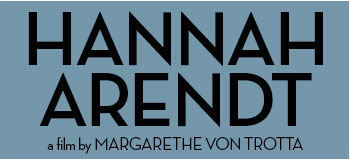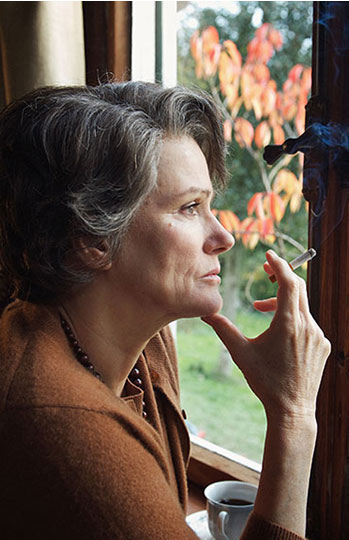HISTORICAL BIOS
Hannah Arendt
Heinrich Blücher
Kurt Blumenfeld
Adolf Eichmann
Martin Heidegger
Hans Jonas
Mary McCarthy
HANNAH ARENDT was born on October 14, 1906, in Hanover, Germany. Arendt grew up with social democratic, assimilated Jewish parents. She studied philosophy and theology in Marburg and Heidelberg, where her professors included Karl Jaspers, Edmund Husserl, and Martin Heidegger, with whom she had a love affair. Her first marriage, from 1929 to 1937, was to philosopher Günther Anders. In 1933, after being briefly imprisoned by the Gestapo, she fled via Carlsbad and Geneva to Paris. She worked for the Youth Aliyah, a Jewish organization that helped Jewish children immigrate to Palestine. In Paris, in 1937, she met Heinrich Blücher, a former Communist and self-educated man from a working class background whom she married 1940. After an internment and escape from the infamous detention camp in Gurs, she immigrated to the United States with her husband and mother in 1941.
For many years, she carved out a living by writing articles and working in publishing, until she eventually found a job as executive secretary of the Jewish Cultural Reconstruction organization. In 1951 she obtained American citizenship and in the same year her book The Origins of Totalitarianism—a comprehensive study of the Nazi and Stalinist regimes—was published. This became an instant intellectual classic and launched her career in America. After guest professorships at Princeton and Harvard, she received professorships at the University of Chicago and the New School for Social Research in New York.
In 1958, she published her book The Human Condition. In 1961, she went to Jerusalem to report on the Adolf Eichmann trial for The New Yorker, and her articles were published in the magazine throughout 1963 in five parts. They triggered intense media coverage. She received fierce opposition and devastating criticism, both for her portrayal of the Jewish councils and her portrait of Eichmann. But her subsequent book, Eichmann in Jerusalem: A Report on the Banality of Evil, has achieved a highly respected, if controversial, place in most serious discussions of the Holocaust. It is now regarded as one of her most important books. She died in New York on December 4, 1975.
back to top
HEINRICH BLÜCHER was born in 1899 in Berlin. The son of a factory worker who died before he was born, was raised by his laundress mother. He was drafted into World War I before finishing school, and returned to join the rebellious soldier’s council—one of the many Worker’s Councils who rioted in the streets when the war finally came to an end. Blücher joined Rosa Luxemburg’s Spartacus League and soon afterwards, he became a member of the German Communist Party. He had a hunger for learning—but not for schooling. He also avoided gainful employment in order to read as much as possible—consuming Shakespeare, Marx, Engels and Trotsky.
Although he was a Gentile, in his adventurous quest to educate himself, he joined the “Blue White,” a Zionist youth group. He also worked on various cabaret and film projects before fleeing the Nazi regime in 1933 to Prague, and later to France. It was in Paris that he met and fell quickly in love with Hannah Arendt. After one youthful marriage, and a second to secure citizenship for a girlfriend, Arendt became his third wife. Together they escaped via Spain and Portugal to the U.S., and settled in New York. Blücher lectured at the New School for Social Research, and starting in 1952—despite his lack of even a high school diploma—he taught at Bard College as a Professor of philosophy. Heinrich Blücher died in 1970. In one of his last lectures he anonymously invokes his relationship with Arendt: “What counts now is the mutual insight of two personalities who recognize and respect each other as such; who in effect can say to each other, ‘I guarantee you the development of your personality and you guarantee me the development of mine.’ This is the basis of all real community thinking.” After thirty-four years together, Arendt found it nearly impossible to imagine life without her husband.
back to top
KURT BLUMENFELD was born in 1884 in East Prussia. In 1904 he began studying law in Berlin, Freiburg and Königsberg. In 1909 he began his professional career as party secretary of the Zionist Federation of Germany, later becoming its president. As Secretary General of the World Zionist Federation from 1911 to 1914 he first visited Palestine, where he then emigrated in 1933. Already in 1926, he was the most influential proponent of Zionism in Germany. Hannah Arendt was taken to one of his lectures by her friend Hans Jonas, and although she didn’t convert to Zionism, she formed a lifelong attachment to Blumenfeld. They fiercely debated Zionism, politics, the diaspora, the Holocaust, assimilation, the return to Palestine and the general problem of Jewish identity. Arendt’s coverage of the Eichmann trial and her theories about the “banality of evil” resulted in a painful rejection from her father figure and close friend. When she learned that Blumenfeld was dying, she visited him again in Israel, but the two of them could not bridge their differences. It was one of the great sorrows of Arendt’s life that there was not enough time to achieve a reconciliation with Kurt Blumenfeld before he died in Jersusalem on May 21, 1963.
back to top
ADOLF EICHMANN was born in 1906 in Solingen, Germany. His father was an accountant. Eichmann was a high-school dropout who began, but never completed, his training as a mechanic. In 1927, Eichmann joined the Deutsch-Österreichische Frontkämpfervereinigung (German-Austrian Front Fighters Association). Five years later he joined the Austrian Nazi Party and the SS. In 1935, he was transferred to a newly-formed “Jews Section,” then became Administrator for Jewish Affairs. Ambitious and eager to succeed, he later became head of the Unit IV D 4/4 and IV B4, which was responsible for the overall organization of the deportation of Jews from Germany and the occupied European countries. He oversaw all the logistics, from the compilation of the transports, to the utilization of the railway trains. After the end of World War II, Eichmann fled from an American internment camp. Under a false name and with the support of Catholic monks—as well as a passport from the Vatican—he managed to escape to Argentina. After being tipped off by German Jews who lived nearby, Israeli Mossad agents kidnapped him in 1960. His trial in Jerusalem drew worldwide attention. Over 600 journalists were present when Eichmann declared himself “not guilty as charged.” He was, however, found guilty verdict was sentenced to death by hanging. After his legal appeal was rejected, Adolf Eichmann was hanged in Israel on May 31, 1962. To avoid burying his remains on Israeli soil, he was cremated and his ashes were scattered in the Mediterranean.
back to top
MARTIN HEIDEGGER
was born in 1889 in Messkirch. Before he even turned thirty, he was one of the most prominent philosophers in Germany. His 1927 work, Being and Time, remains his most important book and profoundly influenced 20th century philosophical thought—particularly deconstruction, existentialism and hermeneutics. From 1923 to 1927 he was professor at the University of Marburg, where Hannah Arendt was one of his students. A passionate love affair began between them. The relationship between the married father of two and his nineteen-year-old student was naturally quite problematic. Heidegger adored his brilliant student, but did not want to jeopardize his job or marriage. After Arendt left school their affair finally ended, shortly before her first marriage. And although they had been out of touch for several years, she was shocked and disappointed when Heidegger, her esteemed professor and first love, made the stunning decision to join the Nazi Party in 1933. Despite that turn of events she renewed their friendship in 1950, and with several lengthy interruptions, the relationship remained important to both of them throughout their lives. After the war Heidegger was widely shunned, and it was largely due to Arendt’s efforts that he was finally able to lecture and publish again. She did not forgive his behavior, but always believed that his work must be awarded a prominent place in the canon of Western thought.
back to top
HANS JONAS was born on May 10, 1903, in Mönchengladbach. His father was a textile manufacturer; his mother was the daughter of the Chief Rabbi of Krefeld. Against the wishes of his father, Jonas became involved in Zionist circles. He also began studying philosophy and art history in Freiburg and Marburg, under Martin Heidegger and Edmund Husserl. Jonas met Hannah Arendt when both were young students, and except for one bitter but temporary interruption, they remained friends their entire lives. In August 1933 he immigrated to London; then went to Jerusalem 1935, where in 1944 he joined the Jewish Brigade of the British Army and fought against the Germans. In 1949 he moved to Canada, and then in 1955 finally settled in New Rochelle, New York, where he had a joyous reunion with Arendt and joined her circle of friends. He took guest professorships at various prestigious universities in the U.S., mainly lecturing on the history of philosophy and the humanities. Their friendship was heavily strained by a conflict arising from the release of Arendt’s articles and book on Adolf Eichmann. They didn’t speak for two years, but Jonas’ wife Lore finally helped the two old friends mend their rift.
back to top
MARY McCARTHY was born in Seattle on June 21, 1912, and subsequently orphaned at age six when both of her parents perished in a flu epidemic. A published author by age thirty, she quickly became a renowned writer and feminist. Her most famous book is the 1963 novel The Group, which follows the lives of eight women following their graduation from Vassar College in 1933. The book was an enormous commercial success (it remained on the New York Times’ Best Seller list for two years), but controversial for its frank depiction of female sexuality and savaged by many male critics. McCarthy commiserated with Hannah Arendt during this time, as she was being simultaneously attacked for her articles on Adolf Eichmann. McCarthy wrote an impassioned and articulate essay defending Hannah Arendt’s work—and supported her faithfully during the long months of anger and hostility that filled every corner of Arendt’s private and public life. Her friendship with Arendt was committed and passionate—the European and the American together embodied all that was most admirable in powerful intellectual women. The published volume of their letters, Between Friends: The Correspondence 1949-1975, achieved worldwide acclaim. With her outspoken and spirited boldness of expression, McCarthy took part in many literary and political disputes. When Arendt passed away in 1975, it was McCarthy who was entrusted with the responsibility of completing her friend’s unfinished book The Life of the Mind. Mary McCarthy died in New York in 1989.
back to top













